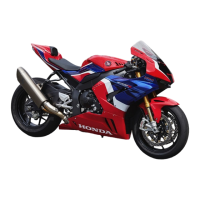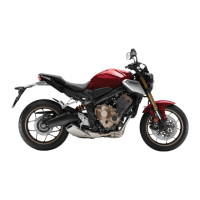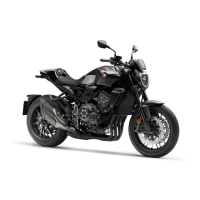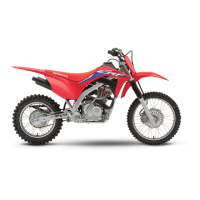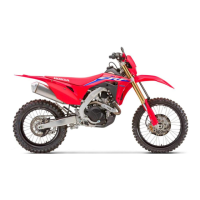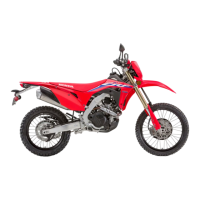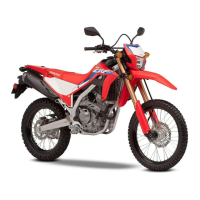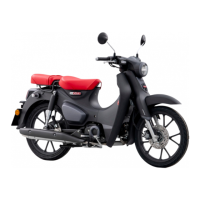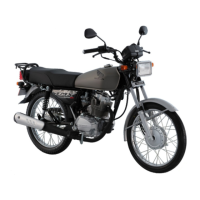Do you have a question about the Honda CBR250RR 2021 and is the answer not in the manual?
Precautions for safe riding, including helmet, apparel, and passenger safety.
Guidelines to enhance safety, including inspections, fuel filling, and engine operation.
Guidelines for running-in, braking, traction, and wet conditions.
Advice against unauthorized accessories and modifications for safety and legality.
Guidelines for carrying extra weight, load limits, and secure luggage placement.
Diagram showing the location of various motorcycle parts and their references.
Explanation of dashboard displays, indicators, and controls.
Identification and function of handlebar switches and controls.
Explanation of different riding modes and how to select them.
Step-by-step procedure for starting the engine.
Explanation of the 6-speed transmission and shifting pattern.
Information on the quick shifter system and its settings.
Instructions and precautions for refuelling the vehicle.
Location and use of helmet holder, tool kit, and document bag.
Emphasizes the necessity of vehicle maintenance for safety and performance.
Provides a schedule of required maintenance tasks and intervals.
Explains basic maintenance principles, safety, and procedures.
Guide to checking the vehicle before riding for safety and convenience.
Lists tools included in the kit for roadside repairs and adjustments.
Steps for removing and installing body panels like seats and battery.
Steps for removing and installing the vehicle battery.
Instructions for removing and installing the front seat.
Instructions for removing and installing the rear seat.
Detailed steps for checking and adding engine oil.
Guide to checking and adding coolant to the reserve tank.
Procedures for checking brake fluid, pads, and adjusting the brakelight switch.
How to check the level and condition of brake fluid.
How to check brake pad wear indicators.
Checks for smooth operation and proper function of the side stand.
Procedures for checking drive chain slack and condition.
Steps for checking and adjusting clutch lever freeplay.
How to measure and check clutch lever freeplay.
Steps for minor and major adjustments to clutch lever freeplay.
How to check the smooth operation of the throttle.
Information on adjusting rear suspension spring preload.
Guide to adjusting spring preload for different loads or surfaces.
Steps to diagnose and resolve engine starting issues.
Diagnosis and procedure for engine overheating indicated by coolant gauge.
Explains the meaning and actions for various warning lights.
Action to take if the low oil pressure indicator comes on.
What to do if the PGM-FI warning light comes on while riding.
Actions to take if the ABS indicator operates abnormally.
Advice on emergency tyre repair and replacement.
Troubleshooting for dead battery, burned-out bulbs, and blown fuses.
Instructions for charging a dead motorcycle battery.
How to inspect and replace blown fuses in the fuse box and main fuse.
Information on ignition keys, key tags, and making duplicates.
Overview of ignition switch, engine stop switch, odometer, and other features.
Proper use of the ignition switch, including warnings.
Correct use of the engine stop switch, especially in emergencies.
Details on tripmeter, document bag, ignition cut-off system, clutch, and throttle systems.
Guidelines for cleaning, polishing, and maintaining the vehicle's appearance.
Safe practices for washing the vehicle to avoid damage.
How to clean aluminium parts and panels without causing scratches.
Cleaning instructions for windscreen and exhaust pipe/muffler.
Guidelines for storing the vehicle for extended periods.
Proper methods and precautions for transporting the motorcycle.
Advice on using sensible cleaners and recycling wastes.
Location and importance of frame and engine serial numbers.
Information on using fuels with alcohol content and potential damage.
Guidelines to protect the vehicle's catalytic converters.
Lists key dimensions and specifications of the vehicle.
Provides technical data for maintenance, including tyre specs, fluids, and spark plugs.
Lists specifications for vehicle bulbs and fuses.
Precautions for safe riding, including helmet, apparel, and passenger safety.
Guidelines to enhance safety, including inspections, fuel filling, and engine operation.
Guidelines for running-in, braking, traction, and wet conditions.
Advice against unauthorized accessories and modifications for safety and legality.
Guidelines for carrying extra weight, load limits, and secure luggage placement.
Diagram showing the location of various motorcycle parts and their references.
Explanation of dashboard displays, indicators, and controls.
Identification and function of handlebar switches and controls.
Explanation of different riding modes and how to select them.
Step-by-step procedure for starting the engine.
Explanation of the 6-speed transmission and shifting pattern.
Information on the quick shifter system and its settings.
Instructions and precautions for refuelling the vehicle.
Location and use of helmet holder, tool kit, and document bag.
Emphasizes the necessity of vehicle maintenance for safety and performance.
Provides a schedule of required maintenance tasks and intervals.
Explains basic maintenance principles, safety, and procedures.
Guide to checking the vehicle before riding for safety and convenience.
Lists tools included in the kit for roadside repairs and adjustments.
Steps for removing and installing body panels like seats and battery.
Steps for removing and installing the vehicle battery.
Instructions for removing and installing the front seat.
Instructions for removing and installing the rear seat.
Detailed steps for checking and adding engine oil.
Guide to checking and adding coolant to the reserve tank.
Procedures for checking brake fluid, pads, and adjusting the brakelight switch.
How to check the level and condition of brake fluid.
How to check brake pad wear indicators.
Checks for smooth operation and proper function of the side stand.
Procedures for checking drive chain slack and condition.
Steps for checking and adjusting clutch lever freeplay.
How to measure and check clutch lever freeplay.
Steps for minor and major adjustments to clutch lever freeplay.
How to check the smooth operation of the throttle.
Information on adjusting rear suspension spring preload.
Guide to adjusting spring preload for different loads or surfaces.
Steps to diagnose and resolve engine starting issues.
Diagnosis and procedure for engine overheating indicated by coolant gauge.
Explains the meaning and actions for various warning lights.
Action to take if the low oil pressure indicator comes on.
What to do if the PGM-FI warning light comes on while riding.
Actions to take if the ABS indicator operates abnormally.
Advice on emergency tyre repair and replacement.
Troubleshooting for dead battery, burned-out bulbs, and blown fuses.
Instructions for charging a dead motorcycle battery.
How to inspect and replace blown fuses in the fuse box and main fuse.
Information on ignition keys, key tags, and making duplicates.
Overview of ignition switch, engine stop switch, odometer, and other features.
Proper use of the ignition switch, including warnings.
Correct use of the engine stop switch, especially in emergencies.
Details on tripmeter, document bag, ignition cut-off system, clutch, and throttle systems.
Guidelines for cleaning, polishing, and maintaining the vehicle's appearance.
Safe practices for washing the vehicle to avoid damage.
How to clean aluminium parts and panels without causing scratches.
Cleaning instructions for windscreen and exhaust pipe/muffler.
Guidelines for storing the vehicle for extended periods.
Proper methods and precautions for transporting the motorcycle.
Advice on using sensible cleaners and recycling wastes.
Location and importance of frame and engine serial numbers.
Information on using fuels with alcohol content and potential damage.
Guidelines to protect the vehicle's catalytic converters.
Lists key dimensions and specifications of the vehicle.
Provides technical data for maintenance, including tyre specs, fluids, and spark plugs.
Lists specifications for vehicle bulbs and fuses.
| Displacement | 249.7 cc |
|---|---|
| Bore x Stroke | 62.0 x 41.4 mm |
| Compression Ratio | 11.5:1 |
| Max Torque | 25 Nm @ 11, 000 rpm |
| Transmission | 6-speed |
| Frame Type | Steel truss frame |
| Front Tire | 110/70-17 |
| Rear Tire | 140/70-17 |
| Seat Height | 790 mm |
| Curb Weight | 168 kg |
| Fuel Tank Capacity | 14.5 liters |
| Engine Type | Liquid-cooled, 4-stroke, DOHC, 4-valve, parallel-twin |
| Max Power | 30 kW (41 PS) @ 13, 000 rpm |
| Fuel System | PGM-FI |
| Front Suspension | Inverted telescopic fork |
| Rear Suspension | Pro-Link monoshock |
| Rear Brake | Single Disc, 240mm |
| Front Brake | Single 310mm disc with 2-piston caliper, ABS |
